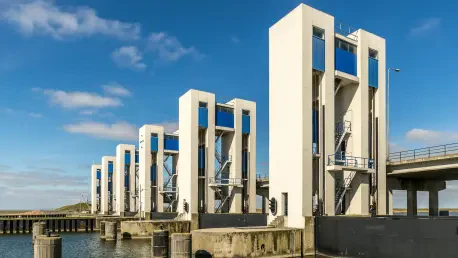What happens when a state’s historic rivers, once the lifeblood of early industry, become the key to a sustainable tomorrow? In Georgia, this isn’t just a thought experiment—it’s a reality unfolding through Georgia Power’s ambitious overhaul of its hydroelectric fleet, serving over 2 million customers who rely on a steady, clean energy supply. With this initiative, the utility giant is breathing new life into aging dams and turbines, ensuring these century-old assets meet modern demands. This story dives into how a blend of innovation and legacy is shaping the state’s energy landscape for generations ahead.
Why Hydro Power Is Georgia’s Green Lifeline
As Georgia’s population booms and energy needs soar, the urgency for reliable, carbon-free power has never been greater. Hydroelectric energy, generating over 1,100 MW through 66 units across 16 facilities, stands as a cornerstone of Georgia Power’s portfolio. This isn’t just about keeping the lights on—it’s about slashing carbon emissions in a world racing against climate change. Modernizing these plants, many built in the early 1900s, addresses the dual challenge of aging infrastructure and stricter environmental goals, positioning hydro as a vital piece of the state’s energy puzzle.
The stakes couldn’t be higher. With facilities nearing the end of their operational life, delays in upgrades risk outages and inefficiency. Georgia Power’s response, backed by regulatory support, underscores a commitment to reliability while aligning with federal standards. This initiative isn’t merely maintenance; it’s a strategic move to sustain a dispatchable, clean resource amid growing demand.
A Blueprint for Hydro Renewal
Georgia Power’s modernization plan spans multiple facilities with a meticulous, tailored approach to upgrades. Key efforts include replacing outdated turbines and generators, as well as revamping balance of plant systems like lubricating oil and control mechanisms. The goal? Extend the lifespan of these plants by at least 40 years, ensuring they remain operational well into the future. Approved through strategic planning with the Georgia Public Service Commission, these investments also meet Federal Energy Regulatory Commission licensing requirements.
Specific projects highlight the scale of this endeavor. At Plant Tugalo near Turnerville, all four units have been fully modernized with new generators and turbines. Meanwhile, Bartlett’s Ferry, located on the Chattahoochee River, saw Unit 1 return to service this year, with work progressing on the remaining units through generator rewinds and equipment replacements. Other sites, including Yonah, Nacoochee, and Sinclair, are also receiving critical updates, showcasing a systematic push to enhance the entire fleet.
Efficiency remains a core focus of these efforts. Upgraded systems reduce downtime, optimize energy output, and bolster performance to support Georgia’s expanding needs. By targeting both major components and smaller operational systems, Georgia Power ensures each facility operates at peak capacity, delivering consistent power to homes and businesses statewide.
Insights from the Heart of the Mission
“This work goes beyond fixing old equipment—it’s about preserving a legacy that powers Georgia while adapting to tomorrow’s challenges,” notes Rick Anderson, senior vice president and senior production officer at Georgia Power. His words reflect the balance of honoring history and embracing innovation that drives this program. At plants like Terrora and Tugalo, teams have tackled complex upgrades, overcoming technical hurdles to restore full functionality.
Regulatory backing from the Georgia Public Service Commission has been instrumental, aligning these projects with broader state energy goals. Engineers and project leaders on the ground report a shared sense of purpose, knowing their efforts directly impact millions of customers. Their stories reveal not just the scale of the technical achievements but also the dedication to ensuring these historic plants remain a reliable energy source.
The human element adds depth to this technical journey. From late-night shifts to coordinate turbine installations to community outreach explaining the benefits of these upgrades, the frontline perspective underscores a collective vision. This modernization isn’t just about machines—it’s about securing a stable future for Georgia’s energy grid and the people who depend on it.
Real-World Benefits of a Modern Fleet
For over 2 million Georgians, the impact of this hydro overhaul translates to fewer power interruptions and a more dependable grid. Enhanced equipment and extended facility lifespans mean outages become less frequent, even as energy demands climb. This reliability isn’t a luxury—it’s a necessity for homes, businesses, and industries navigating rapid growth across the state.
Beyond stability, the environmental benefits are undeniable. Hydro power, as a carbon-free and dispatchable resource, plays a crucial role in cutting reliance on fossil fuels. These upgrades align with sustainability targets, helping Georgia Power contribute to a cleaner energy mix while meeting stringent ecological standards. It’s a practical step toward reducing the state’s carbon footprint.
Economically, the ripple effects are just as significant. Modernization projects create jobs, from engineering roles to local construction crews, boosting communities near these facilities. Additionally, long-term energy stability supports business growth, attracting investment to a state powered by a forward-thinking utility. These tangible outcomes highlight how infrastructure investment fuels both environmental and economic progress.
Strategies for a Growing State
Looking ahead, Georgia Power is crafting strategies to balance soaring energy needs with ongoing infrastructure improvements. As Georgia’s population continues to surge, the utility is planning phased upgrades across its hydro fleet to avoid disruptions. This proactive approach ensures that capacity keeps pace with demand, preventing strain on the grid during peak growth periods.
Community engagement also forms a critical part of the plan. By communicating the value of these projects, Georgia Power builds trust with stakeholders, ensuring transparency about timelines and benefits. This dialogue helps align public expectations with the realities of large-scale energy transitions, fostering support for sustainable initiatives.
Adaptability remains key to future success. Whether integrating new technologies or responding to evolving federal regulations, Georgia Power’s framework prioritizes flexibility. This mindset prepares the utility to address unforeseen challenges, ensuring that hydroelectric power remains a steadfast component of Georgia’s energy strategy for decades to come.
Reflecting on a Legacy of Progress
Looking back, Georgia Power’s hydro modernization efforts marked a pivotal chapter in the state’s energy history. The successful upgrades at facilities like Tugalo and Bartlett’s Ferry stood as testaments to what strategic vision and technical expertise could achieve. These projects not only revitalized aging infrastructure but also reinforced hydro power’s role as a clean, reliable resource.
Moving forward, the focus shifts to sustaining momentum. Continued investment in remaining facilities promises to further strengthen the grid, while innovative approaches aim to tackle emerging energy challenges. Stakeholders are encouraged to stay informed about upcoming phases, recognizing their role in supporting a sustainable energy future.
Ultimately, the journey highlights a powerful truth: blending history with modernity can yield lasting solutions. As Georgia Power paves the way, the path ahead invites collaboration and vigilance to ensure that clean energy remains within reach for every Georgian.









